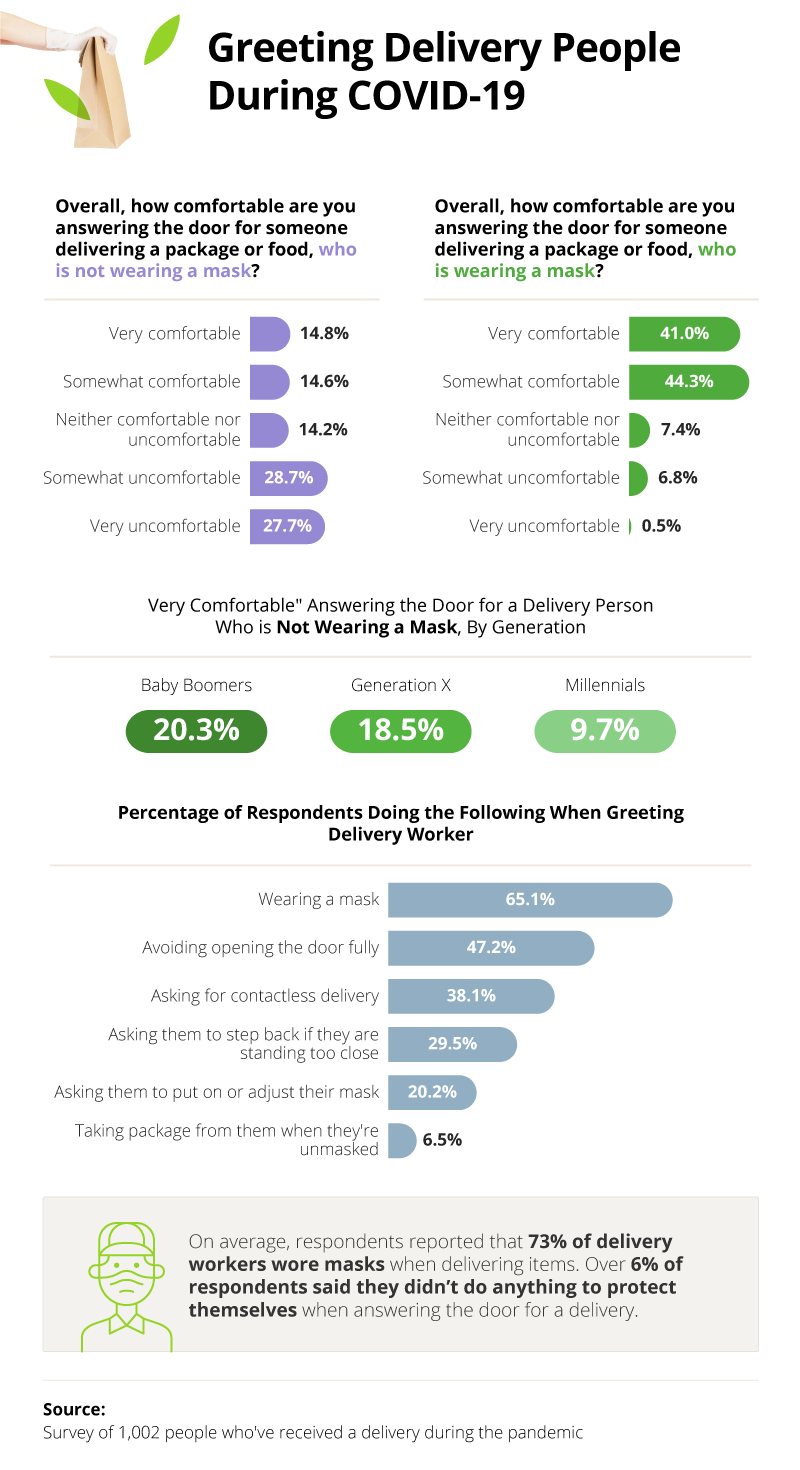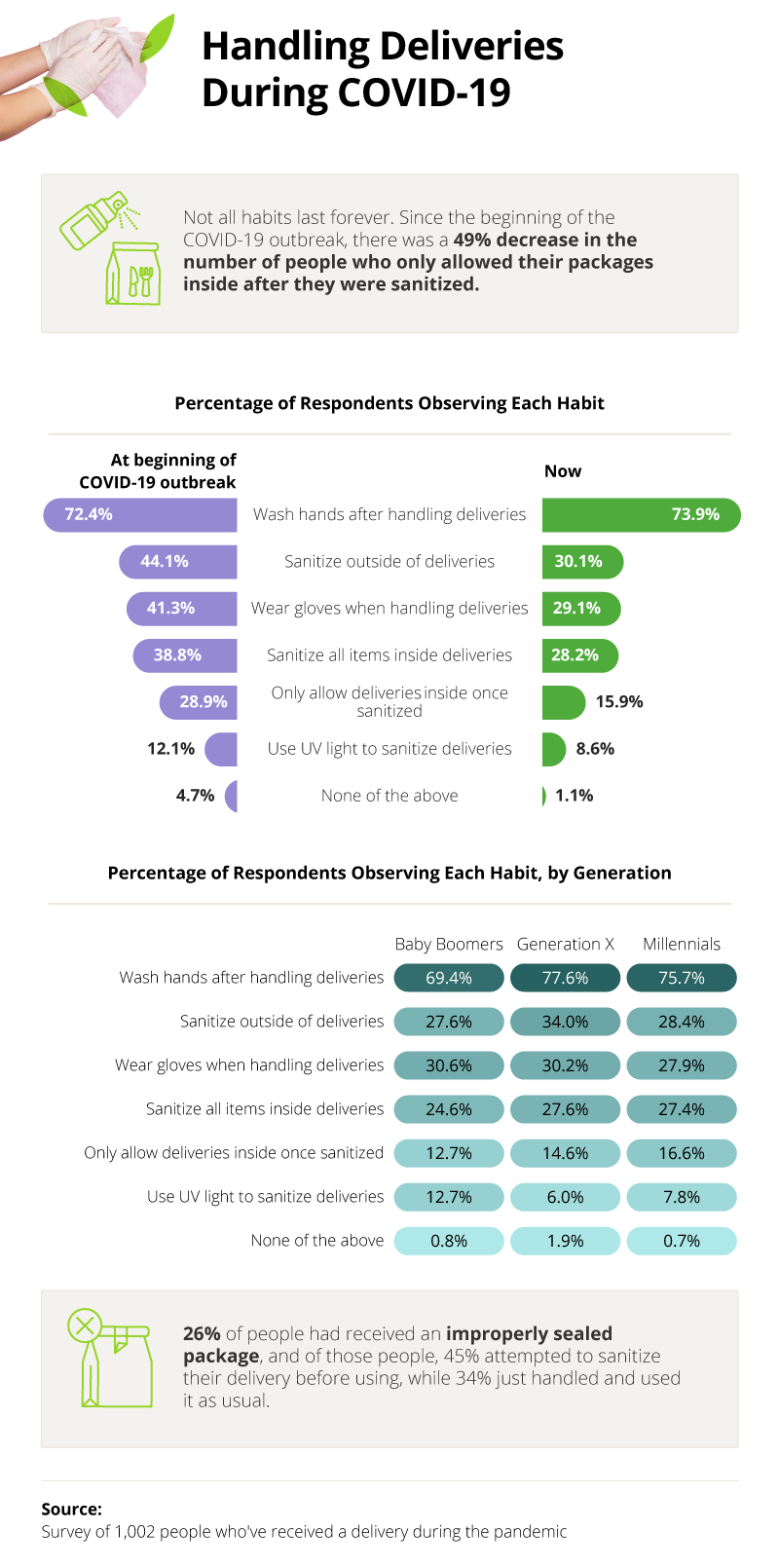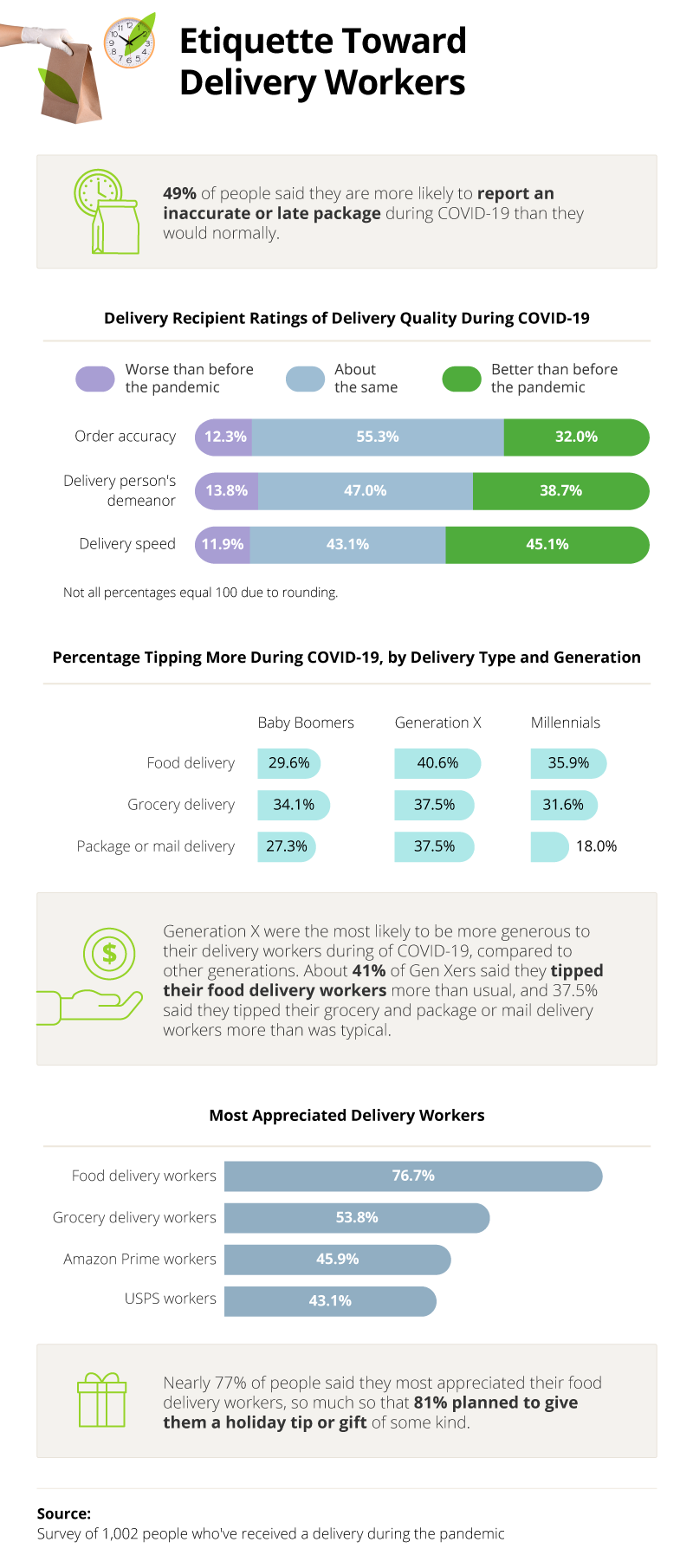Delivery Etiquette During Covid
Taking an In-Depth Look at How
Covid-19 Affected Delivery Etiquette
Delivery services have been around for decades, with technological advancements making it increasingly easy to order from restaurants, grocery stores, and companies all over the world.
Rapidly changing the industry, online food delivery is expected to exceed $200 billion in revenue by 2025, while FedEx and UPS up their shipping techniques to compete with the retail giant Amazon. But thanks to COVID-19, the online food delivery industry might hit that number sooner, while reliance on online shopping has driven shipping trends upward.
Despite delivery services adopting a contactless feature, has the surge in food and package delivery impacted the way customers treat delivery people?
And on the other side of the transaction, are delivery people taking the proper precautions to ensure germs aren’t exchanged along with goods? We surveyed over 1,000 people who have received a package or delivery during the pandemic to find out.
Greeted With a Mask
Before the pandemic, deliveries came with a knock at the door and a smile. Now, over 56% of people receiving deliveries feel at least somewhat uncomfortable answering the door for someone who isn’t wearing a mask.
Surprisingly, baby boomers were the most likely to be comfortable answering the door for a delivery person not wearing a mask despite being the generation most at risk for severe cases of COVID-19.

Across all respondents, a mask was typically all it took for them to be comfortable answering the door. Forty-four percent of people reported feeling somewhat comfortable answering the door to a masked delivery person, while 41% felt very comfortable.
Only 0.5% of people felt very uncomfortable answering the door for a masked delivery person.
As far as protecting themselves, 65% of people wore a mask when answering the door, while 47.2% avoided opening the door all the way. Nearly 40% of people also took advantage of the contactless delivery feature rolled out by numerous services.
In comparison, 29.5% and 20.2% asked a delivery person to step back if they were too close and to don or adjust a mask, respectively. On the other hand, just over 6% of respondents said they didn’t do anything to protect themselves when opening the door for a delivery.

When it came to food delivery, users of Uber Eats reported being the most comfortable receiving deliveries (45%), compared to DoorDash (32%) and Postmates users (29%).
Receiving Habits
When news of COVID-19 first broke and lockdowns began, shopping for groceries or having them delivered meant wiping down each product before bringing it inside.
However, as we learned more about the virus and how it is transmitted, pandemic habits changed. Since the beginning of the COVID-19 outbreak, there was a 49% decrease in the number of people who only allowed deliveries inside after they were sanitized, while hand washing has increased since the beginning of the outbreak.

Washing hands after handling packages remained largely the same throughout the pandemic, with 72.4% practicing the habit at the beginning of the outbreak, and 73.9% doing so now.
Across the generations, Gen Xers were the most likely to wash their hands after handling packages, as well as sanitize the outside and inside items of deliveries. On the other hand, baby boomers were the most likely to wear gloves when handling deliveries and to use UV light to sanitize packages.
Showing Appreciation
Pre-pandemic and in the midst of it, delivery services often come with mistakes. Whether it’s a wrong item or late arrival, customers often expect perfection and can react negatively when they don’t get it.
Across the pond, delivery people became the unsung heroes of the COVID-19 pandemic, but closer to home, were people as grateful?

According to our respondents, 32% reported the accuracy of orders to be better than before the pandemic, while just 12.3% claimed it was worse.
Similarly, nearly 39% reported the delivery person’s demeanor to be better than pre-pandemic, and 45% said the speed of delivery was better, too.
Despite the better service, people didn’t always give delivery workers more slack. Nearly half of people said they were more likely to report an inaccurate or late package during COVID-19 than they would normally.
Nevertheless, a significant portion of customers shared their appreciation for delivery workers. About 38% of people receiving food deliveries tipped more generously since the pandemic began, while 34.4% of those receiving grocery deliveries and 28.5% of those receiving package or mail deliveries said the same.
And even if tips remained the same, sentiments certainly changed: Nearly 77% of people said they most appreciated their food delivery workers, so much so that 81% were planning on giving them a holiday tip or gift.
Be Courteous to Convenience
From the way we interact with others to the way we shop, the COVID-19 pandemic has changed nearly every aspect of our lives. Food, grocery, and package delivery services have seen an enormous spike in orders, and the way customers approach delivery workers has evolved as well.
Between more caution when opening the door and changing habits in terms of sanitizing products, the one thing that seemed to remain the same was customer expectations. While people were more likely to report mistakes and long wait times compared to pre-pandemic, a significant portion was also more likely to express their appreciation.
Whether you’ve been taking advantage of contactless deliveries since the start of the pandemic or are just now considering the benefits, remember the sacrifice and risk delivery workers are taking to deliver your food, groceries, or packages the next time you place an order.
At Mercato, our employees are taking the necessary precautions to deliver local goods straight to your door. We make connecting you with your community a priority, without sacrificing convenience or safety. To place an order for fresh baked goods or homegrown vegetables, visit us online today.
Methodology and Limitations
We surveyed 1,002 respondents who indicated they had received a package or delivery during COVID-19 in order to explore how people are typically interacting with food, package, or grocery delivery workers and how they are handling these packages during COVID-19.
Our respondents ranged in age from 18 to 77. The mean age was 40 with a standard deviation of 13 years. 52% of our respondents identified as female, and 48% identified as male. 49% of survey respondents identified as millennials, 30% as Generation X, and 16% as baby boomers. Sample sizes for other generations were not sufficient enough for our analysis.
Survey data has certain limitations related to self-reporting. These limitations include telescoping, exaggeration, and selective memory. We didn’t weight our data or statistically test our hypotheses. The mission of this project was to explore how consumers react to their delivery workers and their perceptions of etiquette during COVID-19.
Fair Use Statement
We’ve all likely taken advantage of delivery at least once during the pandemic, but the people delivering to us shouldn’t be taken advantage of. If you know someone who could use a reminder on etiquette or is interested in the precautions taken by deliverers, feel free to share this project for noncommercial purposes. Just make sure to include a link back to this page so our contributors receive proper credit.
